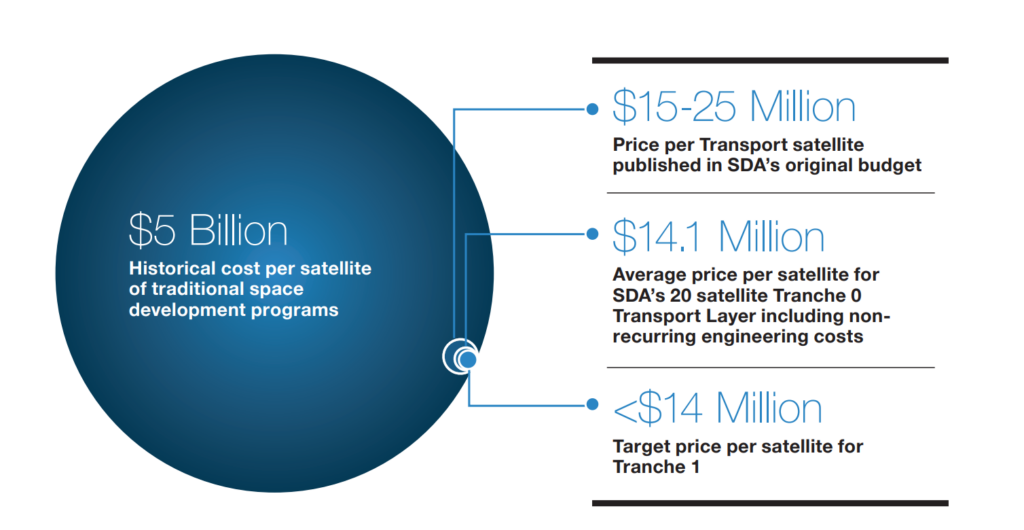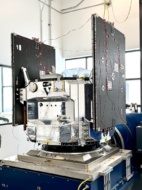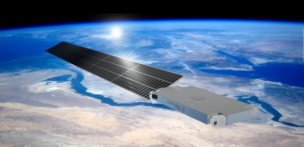Note: This article refers to the National Defense Space Architecture (NDSA), which has since been renamed the Proliferated Warfighter Space Architecture (PWSA).
Over the last few years, the space industry has grown by leaps and bounds, pushing our space capabilities forward at an unprecedented rate.
While its weapons systems may be fast, the Pentagon’s procurement process isn’t exactly known for its speed. Acquisition of new technology platforms is notoriously lengthy and complicated, and in the past, it’s been difficult for top brass to equip the warfighter with cutting-edge commercial technology as it’s developed and ready to be deployed.
Still, the DoD is actively seeking ways that it can take advantage of the strides being made by the domestic space industry.
“The traditional ways of doing space acquisition must be reformed in order to add speed to our acquisitions to meet our priorities,” Frank Calvelli, US Air Force acquisition lead, said in a recent memorandum. “Former approaches of developing a small amount of large satellites, along with large monolithic ground systems taking many years to develop, can no longer be the norm.”
In 2019, the Defense Department stood up the Space Development Agency (SDA). Originally an independent defense agency, the SDA was given a mandate to move fast to put newly emerging technologies into the warfighter’s hands. The SDA is now part of the Space Force, but its mission remains the same.
The architects: an origin story
The SDA was the Pentagon’s answer to the lengthy procurement cycles plaguing the adoption of emerging space capabilities.
“A national security space architecture that provides the persistent, resilient, global, low-latency surveillance needed to deter or, if deterrence fails, defeat adversary action is a prerequisite to maintaining our long-term competitive advantage,” then-Secretary of Defense Patrick Shanahan wrote in a 2019 memorandum establishing the agency. “We cannot achieve these goals, and we cannot match the pace our adversaries are setting, if we remain bound by legacy methods and culture.”
The National Defense Space Architecture (NDSA) grew out of these goals. In essence, the NDSA is a tactical LEO network designed to communicate missile warnings; position, navigation, and timing data; and other vital information to wherever it’s needed on the ground as quickly and securely as possible.
“It’s going to enable that data creation and pointed deployment with the least possible latency so that the warfighter can actually do the missions that they need to do on a much more efficient basis,” Frank Turner, technical director of the SDA, told Payload.
“Effective is doing things right, efficiency is doing the right thing. And this will enable us for the first time from a tactical perspective to truly have a global efficiency that we haven’t had before.”
The division of labor
While the SDA is very new on the block, space is old hat for the Pentagon. The DoD is among the earliest adopters of space, as it’s been launching rockets for seven decades and flying satellites for five. Authority and oversight of various defense offices have shifted over the years.
Today, the warfighter’s geostationary (GEO) and mid-Earth orbit (MEO) missile-tracking assets are operated primarily by two other agencies within the DoD: the Missile Defense Agency (MDA) and Space Systems Command (SSC). The three agencies now work closely together to coordinate constellation planning and actions to ensure that the Pentagon’s national defense system in space works as seamlessly as possible.
The MDA is a descendant of the Strategic Defense Initiative (SDI), a 1983 Reagan initiative to consolidate offices across the DoD conducting disparate, incomplete missile defense strategies. Since then, the office has had a handful of names, becoming MDA officially in 2002 after the US exited the Anti-Ballistic Missile Treaty.
MDA operates the Ballistic Missile Defense System (BMDS), which includes a GEO constellation component performing missile detection and tracking duties.
SSC, with a mandate to deliver “lethal and resilient” space capabilities for national defense, also has a long heritage of providing services from space. SSC’s operational sweet spot is in MEO and GEO.
Though the MDA and SSC had been operating space assets for decades, there was still one orbital regime missing. Turner described the NDSA as the LEO portion of the DoD’s space network.
“Everybody is bringing their core competencies or capabilities to the table for an integrated architecture that will provide the supporting missile tracking and missile defense capability that the US desperately needs,” Turner said.
The trains leave on time
To build such a complex system while still adhering to its “move fast” mandate, the SDA broke the architecture down into bite-size chunks known as “tranches.” Taking a page from the Silicon Valley iterative playbook, the SDA envisions each tranche as a new generation of the NDSA. The agency has a set schedule in place to launch a new tranche, carrying a new generation of capabilities, in September of even-numbered years.
By using this timeline, the SDA aims to set expectations and strengthen the DoD’s relationship with private space players.
“One of the things that I always wished for when I was in industry was a schedule from the government that I can truly count on, and demand signals from the government that I can truly count on,” Turner said. “SDA prides itself on providing this schedule and those demands that enable the industry to go out and do the things that they need to be doing to be ready for what, at SDA, is essentially a continuous acquisition process.”
The trains leave on time. If a particular technology isn’t ready in time to launch on one tranche, it can be ready for the next one two years later.
Tranche 0, the first batch of satellites going up for the NDSA, was originally slated to launch in September of this year. That launch was delayed to mid-December, primarily due to chip shortages and SDA contractors’ supply chain issues. The SDA declined to give an estimate for when that launch will occur, but said that it expects the satellites to perform their first demonstrations on schedule next summer.

The tranches
Here’s a succinct description of each tranche from the SDA itself:
- “Tranche 0 (FY22)—Warfighter immersion: The minimum viable product is demonstrating the feasibility of the proliferated architecture in cost, schedule, and scalability towards necessary performance for beyond line of sight targeting and advanced missile detection and tracking.
- Tranche 1 (FY24)—Initial warfighting capability: Regional persistence for tactical data links, advanced missile detection, and beyond line of sight targeting.
- Tranche 2 (FY26)—Global persistence for all in Tranche 1. This will incorporate lessons learned from operating gen 0 for at least two years.
- Tranche 3 (FY28)—Advanced improvements over Tranche 2. This includes better sensitivity for missile tracking, better targeting capabilities for BLOS, additional PNT capabilities, advances in blue/green lasercom and protected RF comm.
- Tranche 4 (FY30)—“Continual advances to the layers, including additional capabilities identified as current or future threats to the warfighter.”
The layers
The NDSA is, at its core, a proliferated LEO constellation, which just means that it’s made up of a large network of small satellites, rather than the traditional handful of “big, juicy targets” in GEO. This approach has the added benefit of drastically lowering price points, as smallsats are far cheaper than the nine-figure GEO satellites usually procured by the DoD.
The SDA categorizes its constellation by function, rather than by satellite. The NDSA is organized into seven “layers,” each performing a vital function of the architecture. Some of these layers are constellations themselves, some are payloads, and some are not physical assets at all. Each layer, however, represents an add-on capability for the overall system.
Support
“Support” is the umbrella term that the SDA uses to describe all the ground stations, launchers, and other infrastructure that lays the foundation for the NDSA to work.
The ground systems piece is the largest function of the Support Layer. The SDA plans to create a system that can be integrated with existing ground stations around the world, ensuring that information can travel wherever it’s needed on the ground as quickly as possible.
Launch is also included in the Support Layer infrastructure. SpaceX won the contract to launch the NDSA’s 28 Tranche 0 satellites, and all payload integration and satellite operations fall under this layer. Side note: the SDA launched its first satellites with SpaceX on the Transporter-2 mission in June 2021.
Transport

The NDSA contains two separate constellations: the Transport and Tracking layers. The first one is the Transport Layer, which will form a mesh network in LEO connected by optical inter-satellite links. These links, which transmit data via laser, can transmit data at light speed using a very narrow beam that is much more difficult to intercept than traditional radio transmission.
“The transport layer is really kind of the heartbeat of the NDSA,” said Turner. All the information transmitted across the architecture will travel through the transport layer. Then, the layer will route it to where it needs to be on the ground.
“So, we’re going to build this mesh network where every satellite has four friends—a friend behind it, a friend in front of it, a friend on the left, and a friend on the right that it talks to, and it talks to all the time,” Turner said. “And those friends talk to their friends, and their friends talk to their friends.” The end result: a global satellite network of besties connected at light speed.
This spatial positioning not only allows information to travel more quickly and securely, but also makes the satellites much more difficult to hit than their higher flying, slower moving counterparts. If an enemy nation were to destroy one satellite in the mesh network, the data could still reroute between the other Transport satellites to get where it needed to go.
20 Transport Layer satellites are slated to launch soon, as part of Tranche 0.
Tracking
The Tracking layer is the second constellation, and it does the actual remote sensing and Earth observation from LEO.
Tracking Layer birds will be fitted with infrared sensors to spot and track missile threats. These satellites will be connected to the Transport Layer through optical links, and their data can be transmitted across the mesh network and downlinked to the ground.
Tranche 0 will include eight Tracking Layer satellites. The ratio between Transport and Tracking layer satellites is expected to remain roughly proportional as additional tranches are launched and hundreds more satellites are added to the constellations.
Navigation
The Navigation layer is not actually a constellation itself, but rather an added benefit of the mesh network formed by the Transport Layer satellites. By nature of the mesh network spanning the globe, the Transport satellites will be able to transmit precise position, navigation and timing (PNT) data.
“We’re not trying to replace GPS under any circumstance—it’s a core capability that will remain a core capability,” Turner said. “But what we’re doing is for those days when GPS is out of band, that we will have the ability for the warfighter to still know what time it is to the accuracy that they need on a global basis, and to know where they are to the accuracy that they need.”
Battle Management
Each Transport Layer satellite carries a payload hosting a computer to dynamically manage interactions between the satellites as well as the individual layers. This package is referred to as the Battle Management layer. This layer, which will be hosted on most or all NDSA satellites, is tasked with on-orbit processing (or “edge computing”), which can reduce the pain points associated with relaying data.
“If you’re going to move data from point A to point B with the lowest possible latency, one of the things that you want to get away from is the whole idea of coming down to the ground and going back after you’ve done the data processing,” Turner said. The Battle Management layer cuts out that middle step.
Custody
Intelligence, surveillance, and reconnaissance (ISR) functions are the domain of the Custody Layer. The ISR satellites are responsible for detecting and tracking targets on the ground.
The SDA is not planning to launch its own Custody Layer constellation. Part of the appeal of the mesh network is that other assets in orbit can transmit data through the network, eliminating the need for redundant SDA sensing sats. Those other assets could be commercial satellites already collecting sensing data or spy satellites operated by the NRO and other intelligence agencies.
Emerging Capabilities
The final layer of the architecture leaves a little wiggle room for the development of new space technologies. As of this writing, a potential space domain awareness capability is wrapped into this category, meaning that the SDA is still looking into the possibility of deploying or purchasing awareness capabilities.
To identify other emerging technologies, the SDA works closely with other DoD offices and soldiers themselves. When a technology comes to market with the potential to augment the NDSA’s capabilities and provide value to military end users, the SDA has committed to conduct experiments and explore the possibility of rolling those technologies out on a larger scale. Right now, these technologies include tagging and tracking, radio frequency identification, alternative navigation systems, and tactical communications support.
The next few years
The SDA is aiming to stick to its mandate, moving as quickly as possible over the next few years to get a functional architecture in place for the warfighter. As it’s currently envisioned, the NDSA taps into many zeitgeisty space technology concepts, from optical links to on-orbit processing.
The Pentagon will be watching closely to see how the technology takes shape in low Earth orbit, alongside (or in contrast) to that of other players developing similar capabilities. In terms of what’s next, the first Tranche 0 launch could happen as early as mid-December. It’s entirely possible that it could slip into the new year (see: Berger’s law).
After its first NDSA launch, the SDA plans to continue launching tranches containing new generations of Transport and Tracking Layer satellites (and all the capabilities that come with them) with the “trains on time” mentality.




